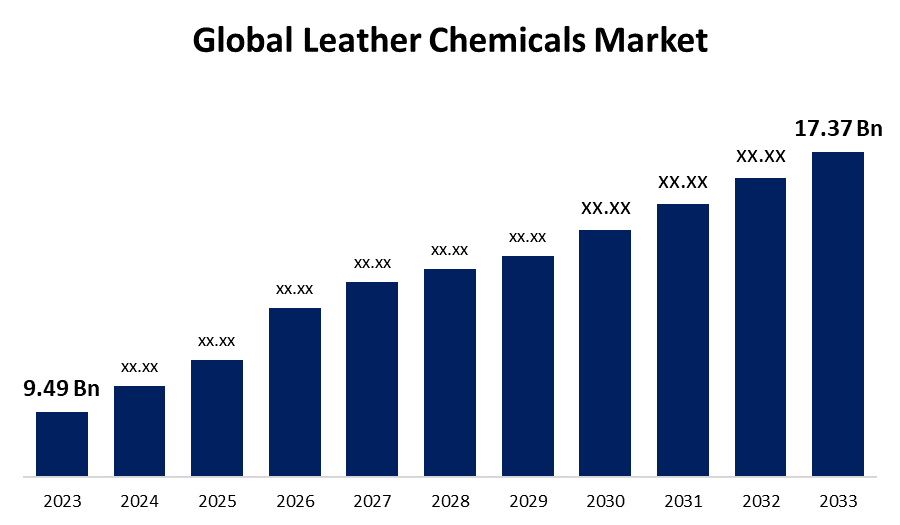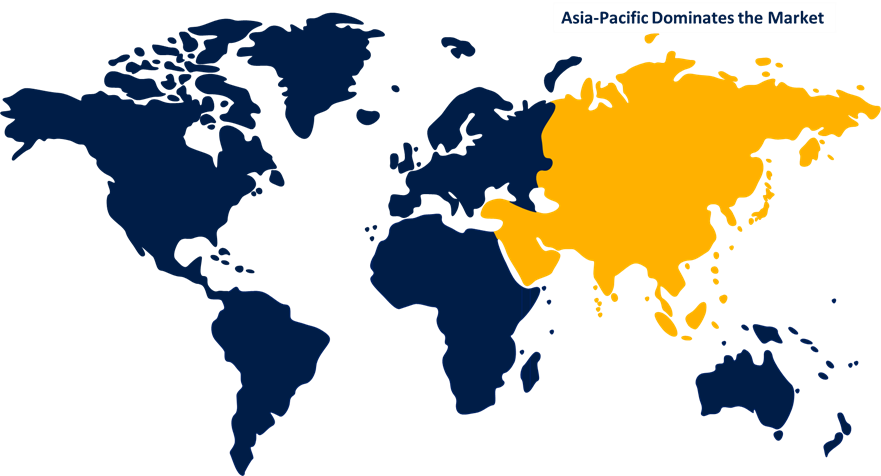Global Leather Chemicals Market Size, Share, and COVID-19 Impact Analysis, By Type (Tanning and Dyeing Chemicals, Beam House Chemicals, and Finishing Chemicals), By Product (Biocides, Surfactants, Chromium Sulfate, Polyurethane Resins, and Sodium Bicarbonate), By End-User (Footwear, Furniture, Automotive, and Textile), and By Region (North America, Europe, Asia-Pacific, Latin America, Middle East, and Africa), Analysis and Forecast 2023 - 2033
Industry: Chemicals & MaterialsGlobal Leather Chemicals Market Insights Forecasts to 2033
- The Global Leather Chemicals Market Size was Valued at USD 9.49 Billion in 2023
- The Market Size is Growing at a CAGR of 6.23% from 2023 to 2033
- The Worldwide Leather Chemicals Size is Expected to Reach USD 17.37 Billion by 2033
- Europe is expected to Grow the fastest during the forecast period.

Get more details on this report -
The Global Leather Chemicals Market Size is Anticipated to Exceed USD 17.37 Billion by 2033, Growing at a CAGR of 6.23% from 2023 to 2033.
Market Overview:
Leather chemical is known as the chemical compound used to increase the quality of leather products, decrease water consumption during manufacturing, and make more efficient process formulation. They are divided into three main types such as pre-tanning, tanning, and finishing chemicals which are widely used at various stages of leather manufacturing processes and play crucial roles in the rising color, texture, and quality of leather products. The automotive industry is one of the biggest clients of leather chemicals that can boost market growth. The automotive industry is increasing continually, particularly in emerging nations, which is generating the demand for superior leather interiors. For instance, according to the International Trade Administration china is the world’s biggest vehicle market in both yearly sales and manufacturing output with local production predicted to reach 35 million vehicles by 2025. The growth of the textile and footwear businesses is driving the evolution of the worldwide market for leather chemicals. The strong Indian economy supports the leather chemical and supplementary industries. According to the Indian trade portal country accounted the 13% of the world’s total leather production and second largest manufacturer of leather footwear this will help to enhance the market growth. The government scheme is also supporting the growth of the market. For instance, the integrated development of the leather sector scheme by the government of India is to inspire business entrepreneurs to expand and set up novel units for improved output.
Report Coverage:
This research report categorizes the market for the global leather chemicals market based on various segments and regions forecasts revenue growth and analyses trends in each submarket. The report analyses the key growth drivers, opportunities, and challenges influencing the global leather chemicals market. Recent market developments and competitive strategies such as expansion, product launch, and development, partnership, merger, and acquisition have been included to draw the competitive landscape in the market. The report strategically identifies and profiles the key market players and analyses their core competencies in each sub-segment of the global leather chemicals market.
Global Leather Chemicals Market Report Coverage
| Report Coverage | Details |
|---|---|
| Base Year: | 2023 |
| Market Size in 2023: | USD 9.49 Billion |
| Forecast Period: | 2023 - 2033 |
| Forecast Period CAGR 2023 - 2033 : | 6.23% |
| 2033 Value Projection: | USD 17.37 Billion |
| Historical Data for: | 2019 - 2022 |
| No. of Pages: | 210 |
| Tables, Charts & Figures: | 120 |
| Segments covered: | By Type, By Product, By End-User, and By Region. |
| Companies covered:: | Lanxess AG, Pidilite Industries Limited, Schill + Seilacher GmbH, Stahl Holdings B.V, TFL Ledertechnik GmbH, Zschimmer, Schwarz Chemie GmbH, Abhilash Chemicals and Pharmaceuticals Pvt Ltd, BASF SE, DuPont de Nemours Inc, DyStar Singapore Pte Ltd, Eastman Chemical Company, Indofil Industries Limited, HARYANA leather chemicals ltd, Clariant AG, and Others |
| Pitfalls & Challenges: | COVID-19 Empact, Challenge, Future, Growth, & Analysis |
Get more details on this report -
Driving Factors:
The mounting demand for leather products, across the fashion trend, automotive, and furniture businesses, driven by growing discretionary income, altering customer existences, and mode trends, is a key factor expected to the growth of the leather chemicals market. Evolutions in leather refining technologies, including enzyme-based processes, chrome tanning, and digital printing help transform the leather industry. The growing demand for automotive fabric and rising footwear and textile trades will help to boost the growth of the market.
Restraining Factors:
The risk of hazardous environmental effects of leather chemicals and health-associated risks in workers might restrict the growth of the market.
Market Segmentation:
The global leather chemicals market share is classified into type, product, and end-user.
- The tanning and dyeing chemicals are expected to have the largest share of the market during the forecast period.
Based on the type, the global leather chemicals market is categorized into tanning and dyeing chemicals, beam house chemicals, and finishing chemicals. Among these, tanning and dyeing chemicals are expected to have the largest share of the market during the forecast period. Tanning chemicals, such as chromium, vegetable, and synthetic tanning agents, make leather more resistant to disintegration and improve its physical characteristics. Dyeing chemicals provide desirable colors and decorative finishes to leather items, making them suitable for a variety of uses including automotive, footwear, fashion, and furniture. Furthermore, the increased demand for excellent quality, and resilient leather is driving improvements in chemical formulations that provide higher efficiency and sustainable development, which is increasing the leather chemicals market share.
- The polyurethane resins segment has the biggest share of the market over the forecast period.
Based on the product, the global leather chemicals market is categorized into biocides, surfactants, chromium sulfate, polyurethane resins, and sodium bicarbonate. Among these, the polyurethane resins segment has the biggest share of the market over the forecast period. The most frequent plastics used in leather manufacture are polyurethane resins, which operate as a bonding agent in the retention and finishing processes as well as to build coating layers. Since the distinctive group of polyurethane resin and the peptide chain in collagen are comparable, polyurethane resin-retained leathers can retain the feel of genuine leather. Polyurethane resins are also appealing coating materials in finishing due to their outstanding flexibility, better handling, and adhesive durability.
- The footwear segment has the greatest share of the market throughout the estimated period.
Based on the end-user, the global leather chemicals market is categorized into footwear, furniture, automotive, and textile. Among these, the footwear segment has the greatest share of the market throughout the estimated period. The augmented demand for leather footwear, powered by growing financial resources, existing trends in fashion, and the growing number of outdoor and sporting events, is driving up demand for leather chemicals. They advance the aesthetics and efficient features of footwear, making it less vulnerable to wear and tear while upholding a luxury entrance and feel. The Indian leather products, and footwear manufacturing plays a widespread role in the Indian economy. In 2022-23, India exported $5.26 billion worth of footwear and leather products.
Regional Segment Analysis of the Global Leather Chemicals Market
- North America (U.S., Canada, Mexico)
- Europe (Germany, France, U.K., Italy, Spain, Rest of Europe)
- Asia-Pacific (China, Japan, India, Rest of APAC)
- South America (Brazil and the Rest of South America)
- The Middle East and Africa (UAE, South Africa, Rest of MEA)
Asia-Pacific is projected to hold the largest share of the global leather chemicals market over the forecast period.

Get more details on this report -
Asia-Pacific is projected to hold the largest share of the global leather chemicals market over the forecast period. Furthermore, the existence of significant producers and exporters of leather products, such as footwear, clothes, and devices, which necessitate the usage of leather chemicals, is driving market expansion. Aside from that, the region's growing automotive and furniture sectors are driving up demand for high-quality leather, enhancing the leather chemicals sales. Furthermore, rising urbanization and financial resources in the region are contributing to increased buyer demand for leather items, which is supporting market expansion.
Europe region is also expected to fastest CAGR growth during the forecast period. Robust worldwide market links, improved R&D efforts to produce inexpensive leather chemicals, and the arrival of raw materials have all supported Italy's high demand for leather products. These factors have also had a favorable impact on the leather chemicals market in Europe.
Competitive Analysis:
The report offers the appropriate analysis of the key organizations/companies involved within the global leather chemicals market along with a comparative evaluation primarily based on their product offering, business overviews, geographic presence, enterprise strategies, segment market share, and SWOT analysis. The report also provides an elaborative analysis focusing on the current news and developments of the companies, which includes product development, innovations, joint ventures, partnerships, mergers & acquisitions, strategic alliances, and others. This allows for the evaluation of the overall competition within the market.
List of Key Companies:
- Lanxess AG
- Pidilite Industries Limited
- Schill + Seilacher GmbH
- Stahl Holdings B.V
- TFL Ledertechnik GmbH
- Zschimmer
- Schwarz Chemie GmbH
- Abhilash Chemicals and Pharmaceuticals Pvt Ltd
- BASF SE
- DuPont de Nemours Inc
- DyStar Singapore Pte Ltd
- Eastman Chemical Company
- Indofil Industries Limited
- HARYANA leather chemicals ltd
- Clariant AG
- Others
Key Market Developments:
- In January 2024, Pidilite Industries Ltd. formed a strategic relationship with Syn-Bios, an Italian pioneer in R&D and global marketing for the leather tanning sector. Their alliance intends to significantly disrupt the leather chemistry landscape in South Asia.
- In January 2023, the leather sector in Tamil Nadu is making attempts to make its production methods greener through implementing a zero liquid discharge technique, using renewable electricity, recycling, and developing circular products on export demand from the US and Europe.
Key Target Audience
- Market Players
- Investors
- End-users
- Government Authorities
- Consulting And Research Firm
- Venture capitalists
- Value-Added Resellers (VARs)
Market Segment
This study forecasts revenue at global, regional, and country levels from 2020 to 2033. Spherical Insights has segmented the global leather chemicals market based on the below-mentioned segments:
Global Leather Chemicals Market, By Type
- Tanning and Dyeing Chemicals
- Beam House Chemicals
- Finishing Chemicals
Global Leather Chemicals Market, By Product
- Biocides
- Surfactants
- Chromium Sulfate
- Polyurethane Resins
- Sodium Bicarbonate
Global Leather Chemicals Market, By End-User
- Footwear
- Furniture
- Automotive
- Textile
Global Leather Chemicals Market, By Regional
- North America
- US
- Canada
- Mexico
- Europe
- Germany
- Uk
- France
- Italy
- Spain
- Russia
- Rest of Europe
- Asia Pacific
- China
- Japan
- India
- South Korea
- Australia
- Rest of Asia Pacific
- South America
- Brazil
- Argentina
- Rest of South America
- Middle East & Africa
- UAE
- Saudi Arabia
- Qatar
- South Africa
- Rest of the Middle East & Africa
Frequently Asked Questions (FAQ)
-
1. What is the CAGR of the global leather chemicals market over the forecast period?The global leather chemicals market size is expected to grow from USD 9.49 Billion in 2023 to USD 17.37 Billion by 2033, at a CAGR of 6.23% during the forecast period 2023-2033.
-
2. Which region is expected to hold the highest share in the global leather chemicals market?Asia-Pacific is projected to hold the largest share of the global leather chemicals market over the forecast period.
-
3. Who are the top key players in the leather chemicals market?Lanxess AG, Pidilite Industries Limited, Schill + Seilacher GmbH, Stahl Holdings B.V, TFL Ledertechnik GmbH, Zschimmer, Schwarz Chemie GmbH, Abhilash Chemicals and Pharmaceuticals Pvt Ltd, BASF SE, DuPont de Nemours Inc, DyStar Singapore Pte Ltd, Eastman Chemical Company, Indofil Industries Limited, HARYANA leather chemicals ltd, Clariant AG, and Others.
Need help to buy this report?